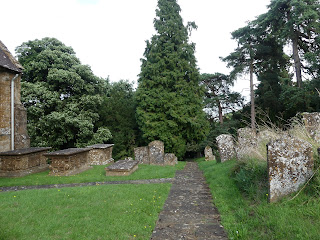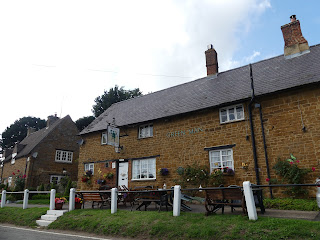Not far from the National Herb Centre is the church of St Michael's, Warmington. It is located outside the village high on a bank by the "B" road. I was determined to stop off and explore at least the churchyard!
According to the church sign the church was built between 1125 and 1345 by Benedictine monks from Normandy.
The church, like many buildings in this area, was constructed of Hornton stone which is a pure ooidal limestone of the Lower Jurassic. The rock formation crops out at the nearby Edge Hill escarpment and the stone has been quarried for building and ornamental purposes since Medieval times. In more recent times it has become a source of iron ore.
Priest's Door with ogee head.
The south aisle is late 13th century and the window has 3 circles in bar tracery.
The East window (exterior)
The West Tower is Decorated to Perpendicular.
The church was open but I didn't go in as D had remained in the car and time was getting on and I had promised we would drive through a few of the villages.
I had really stopped off because I wanted to see the churchyard which has many carved ironstone headstones and table tombs from the 1630's onwards decorated with scrolls, foliage, winged heads, skulls etc. Even Pevsner called it ("an impressive array"), The churchyard seemed large and spread downhill beyond the east end of the church. Due to lack of time I concentrated on the area around the church as apparently some of the lower churchyard was closed any way for safety reasons.
It was interesting to see so many memento mori examples and there is no doubt I shall have to return and explore more. It was good too to see that it was a Warwickshire example of a "living churchyard" with many areas where wild flowers, grasses etc could flourish.
We drove down the lane to the nearby village of Warmington which was very picturesque with houses surrounding a village green and pond.
The houses are built of Hornton stone, some thatched, and most are 17th or 18th century. The manor house below was built around 1600 probably for a Richard Cooper.
We then drove off to the village of Shotteswell which was even more charming and picturesque. I couldn't park as the road through the village was one lane with blind corners but we will definitely return as there is a church there too!
Then onto Mollington - not quite as picturesque but a lovely pub!!
I must admit the detour took longer than planned and we were faced with a return journey on the M40 and M42 in the rush hour!
The villages definitely need further visits and there is another one nearby called Farnborough with an old church and National Trust property!
I hope everyone is staying safe and well.
All photos taken by me with the Panasonic FZ330 bridge camera
Reference: Pevsner Buildings of England Warwickshire (new edition).















































8 comments:
Great to be getting out and about without crowds {unlike here}. Lovely photos of the church and church yard, and as you say on to picturesque villages. I have to say, an ogee arch is a particular favourite arch of mine.
Rustic Pumpkin - Thank you so much. So sorry about your crowds :( The churchyard was empty and the villages quiet. Though as picturesque as the Cotswolds the villages round South Warks/North Oxon don't seem to attract the tourists :) Yes I rather like ogee arches too :)
A lovely looking church. The graveyard looks fascinating.
CherryPie - Thanks so much.
Lovely to meander through all these little villages, there are some lovely buildings. The church looks interesting and the headstones and table tombs in the churchyard fascinating. Hopefully you will be able to go inside the church when you make a retun visit. I assume the Edge Hill escarpment is in the same area as the Civil War Battle? I seen to remember going there many years ago. I wonder if any of the 17th century headstones are connected with that or any references inside:)
Rosie - Thanks so much. I do like wandering round pretty villages - always so many fascinating architectural details etc. :) Yes Edge Hill escarpment is the one in Civil War Battle. You can see over the battle area well from The Castle pub up on the escarpment itself. I think much of battle area now MofD land??? but I might be wrong. In the past we have visited villages Radway and Ratley too nearby that have Civil War connections. One of the churches Radway I think??? has a small Civil War exhibition. The church info board seems to suggest there are some Civil War graves there but I am not sure which ones! I could have done with more time - there again inscriptions possibly weathered away??
Well I've learned what an ogee head is as I had to google that. :-) You certainly know your church architectural terms!
Some lovely villages around the area. I loved the graveyard too, but wonder on the significance of the skulls or skull and crossbones on the tombs. Obviously they are marking where dead people lie, but seems a bit gruesome to me. :-/
Milly mollymandy - Thanks so much. Believe me I have read a lot of books on churches and still keep forgetting things!
They are a bit gruesome skull and crossbones. More common as Memento Mori symbols in the 16th and 17th centuries. They were a reminder of how short mortal lives are and that death comes to everyone one day regardless of their status! Bit eerie as you say! I prefer the birds and flowers and angels!
Post a Comment